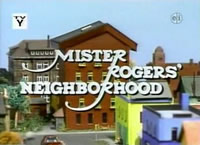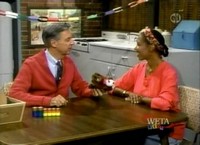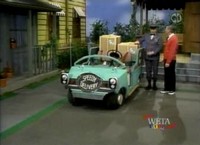Episode 1655
Topic: Learning
Air Date: August 28, 1992
Previous Episode: 1654 - Learning
Next Episode: 1656 - Up & Down
Purchase/Stream: Amazon
 Mister Rogers arrives with a box of batteries of various sizes. He demonstrates what batteries do by closing the curtains and using a flashlight.
Mister Rogers arrives with a box of batteries of various sizes. He demonstrates what batteries do by closing the curtains and using a flashlight.
Mister Rogers starts to sing It's the Style to Wear a Smile but he is interrupted when Maggie Stewart stops by with some other battery-powered items. Sitting together in the kitchen, they demonstrate a battery-powered toy dog before they sing It's the Style to Wear a Smile.
As Mister Rogers continues playing with other toys brought by Maggie Stewart, Mr. McFeely arrives on his new battery-operated delivery car. After trying out the new delivery car, Mr. McFeely and Mister Rogers take down the paper chain inside the house so that it can be delivered to the Neighborhood school.
In the Neighborhood of Make-Believe, Neighbor Aber and Lady Aberlin try out a battery-operated car to be used for field trips. Meanwhile, at the school, the children choose to go on the field trip to learn instead of using James Michael Jones' learning machine.
Back at the house, Mister Rogers concludes by singing It's You I Like.
Notes
Mister Rogers and Maggie Stewart sing a song he refers to in this episode as A Smile's the Style Upon Your Face. However, this song appears on other episodes and releases under the more familiar title It's the Style to Wear a Smile.
The list of castle activities suggested for the children's field trip include: Garden tour, Castle history, Lunch, Sing-a-Long, Ballroom Dance, Trolley Ride, and Bird Watching.
This episode is one of two featured on the 2005 release Going to School. It is also the episode featured on the 1992 VHS release Learning is Everywhere!
Appearing In This Episode
- Ana Platypus
- Daniel Striped Tiger
- Edgar Cooke
- Harriett Elizabeth Cow
- Henrietta Pussycat
- James Michael Jones
- King Friday XIII
- Lady Aberlin
- Maggie Stewart
- Mayor Maggie
- Mister Rogers
- Mr. McFeely
- Neighbor Aber
- Prince Tuesday
Songs
- It's the Style to Wear a Smile
- It's Such a Good Feeling
- It's You I Like
- Speedy Delivery (v2)
- The Weekend Song
- Won't You Be My Neighbor?
Images













Episode Credits
With Fred Rogers
Neighbors: Chuck Aber, Betty Aberlin, Michael Horton, Lenny Meledandri, David Newell, Maggie Stewart, Carole Switala, Bob Trow
Executive Producer: Fred Rogers
Producer: Margaret Whitmer
Director: Bob Walsh
Associate Producer: Adrienne Wehr
Music Director: John Costa
Art Director: Katherine Borland
Editor: Susan Howard
Assistant Art Director: Catherine Stanton
Properties: Matthew Marcus
Production Assistants: Janet Brentley, Lenny Meledandri
Production Intern: Teresa Edmondson
Lead Technician: Ralph Seigler
Production Coordinator: Hugh Downing
Assistant Director: Chelle Robinson
Lighting Director: Frank Warninsky
Lighting Assistants: Jim Bruwelheide, Doug Coates, Thom Downing, Bob Lubomski
Technical Director: Jim Ochtun
Video: Tom Deluga
Audio: Dick LaSota
Studio Cameras: Don McCall, Marji Murphy, Jim Ochtun
Videotape: Bill Moore
Floor Manager: Jim Seech
Assistant Floor Manager: Kate Kearney
Location Production: Joe Abeln, Mark Adelsheim, John Burdick, Bob Lubomski, Teri Murphy, Fred Roth, Tim Zhorne
Scenic Artists: James Desmone, Smith Hutchings, Paula Payne, David Pohl, Alexis Samulski, Sandra Streiff, Beth Ann Zamborsky
Carpenters: Rich Karapandi, Michael Karapandi, Don Kahn
Musicians: Carl McVicker, Bob Rawsthorne
Videotape Editor: Kevin Conrad
Post Production Sound: Dean Becker, Jim Durham, Randy Rhodes
Original Scenic Design: Jack Guest
Director of Production: Sam Newbury
Consultant: Albert V. Corrado, M.D.
Produced in association with WQED/Pittsburgh
A production of Family Communications
© 1992 Family Communications, Inc.
